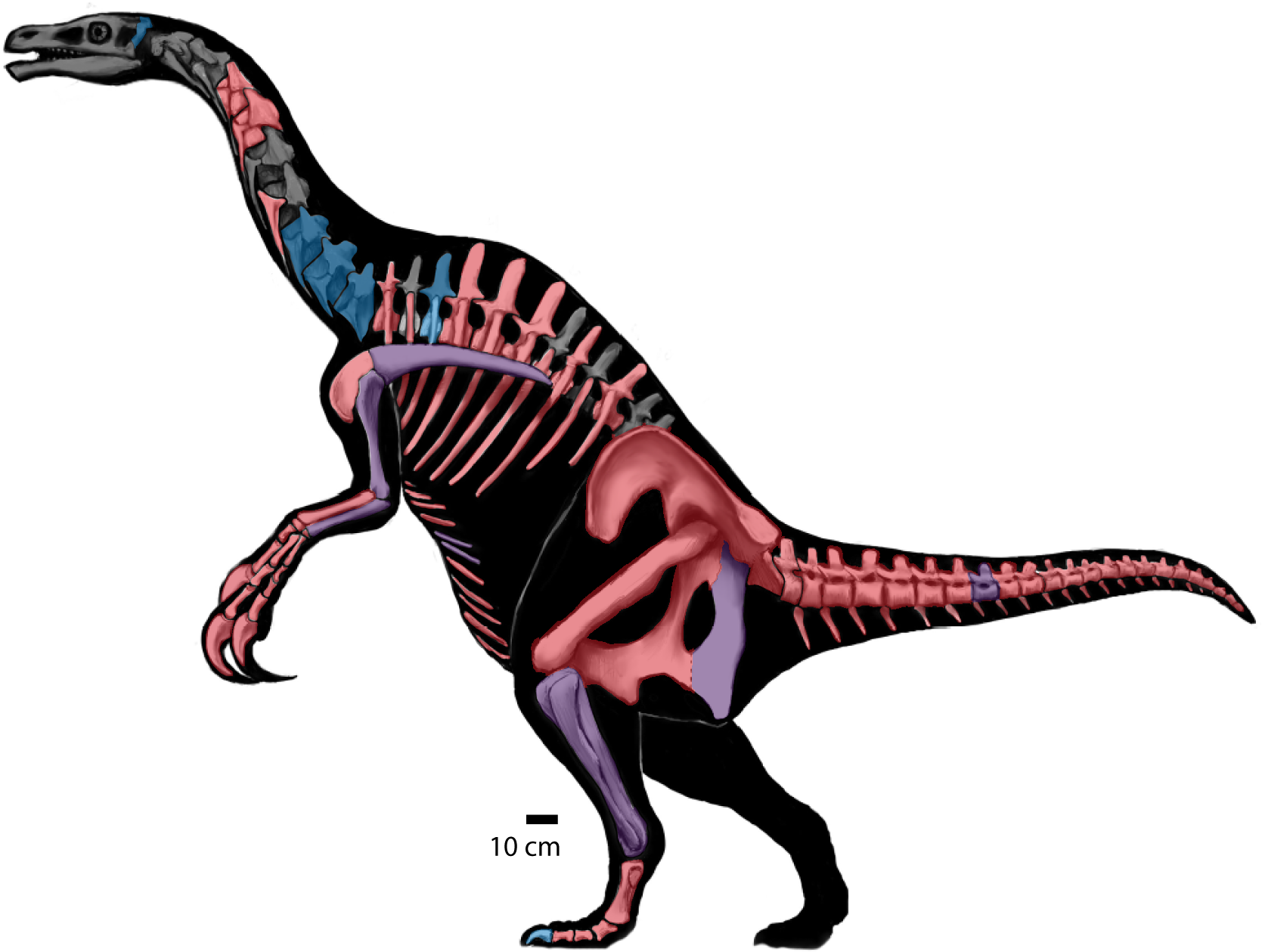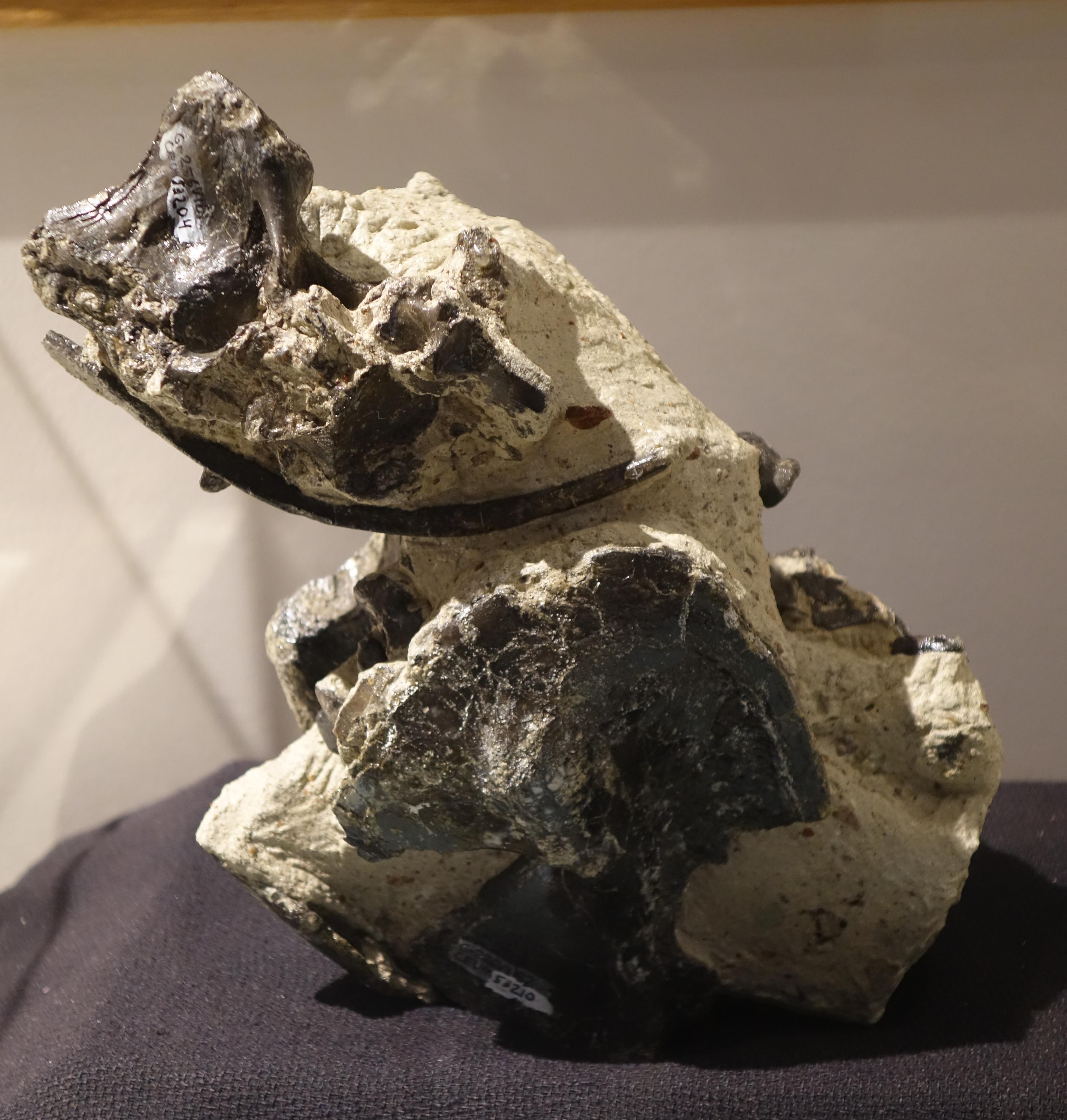|
Eshanosaurus Deguchiianus
''Eshanosaurus'' is a genus of a dinosaur from the early Jurassic Period. It is known only from a fossil partial lower jawbone, found in China. It may be a therizinosaurian, and if so the earliest known coelurosaur. Discovery and naming The type species, ''Eshanosaurus deguchiianus'', was described by Xu Xing, Zhao, and James M. Clark in 2001. The generic name is derived from Eshan. The specific name honours Hikaru Deguchi who convinced Xu that he should study dinosaurs. The type specimen, consisting of three fragments of a fossilized left lower jaw and teeth, was uncovered in the Dull Purplish Beds of the Lower Lufeng Formation in Yunnan, dating to about 196 million years ago (Hettangian stage). The specimen is in the collection of the Institute of Vertebrate Paleontology and Paleoanthropology in Beijing, where it is catalogued under accession number IVPP V11579. Classification The authors who initially described the fossil, classified ''Eshanosaurus'' as a member of the Th ... [...More Info...] [...Related Items...] OR: [Wikipedia] [Google] [Baidu] |
Early Jurassic
The Early Jurassic Epoch (in chronostratigraphy corresponding to the Lower Jurassic Series) is the earliest of three epochs of the Jurassic Period. The Early Jurassic starts immediately after the Triassic-Jurassic extinction event, 201.3 Ma (million years ago), and ends at the start of the Middle Jurassic 174.1 Ma. Certain rocks of marine origin of this age in Europe are called "Lias" and that name was used for the period, as well, in 19th-century geology. In southern Germany rocks of this age are called Black Jurassic. Origin of the name Lias There are two possible origins for the name Lias: the first reason is it was taken by a geologist from an English quarryman's dialect pronunciation of the word "layers"; secondly, sloops from north Cornish ports such as Bude would sail across the Bristol Channel to the Vale of Glamorgan to load up with rock from coastal limestone quarries (lias limestone from South Wales was used throughout North Devon/North Cornwall as it conta ... [...More Info...] [...Related Items...] OR: [Wikipedia] [Google] [Baidu] |
Beijing
} Beijing ( ; ; ), alternatively romanized as Peking ( ), is the capital of the People's Republic of China. It is the center of power and development of the country. Beijing is the world's most populous national capital city, with over 21 million residents. It has an administrative area of , the third in the country after Guangzhou and Shanghai. It is located in Northern China, and is governed as a municipality under the direct administration of the State Council with 16 urban, suburban, and rural districts.Figures based on 2006 statistics published in 2007 National Statistical Yearbook of China and available online at archive. Retrieved 21 April 2009. Beijing is mostly surrounded by Hebei Province with the exception of neighboring Tianjin to the southeast; together, the three divisions form the Jingjinji megalopolis and the national capital region of China. Beijing is a global city and one of the world's leading centres for culture, diplomacy, politics, financ ... [...More Info...] [...Related Items...] OR: [Wikipedia] [Google] [Baidu] |
Sauropodomorpha
Sauropodomorpha ( ; from Greek, meaning "lizard-footed forms") is an extinct clade of long-necked, herbivorous, saurischian dinosaurs that includes the sauropods and their ancestral relatives. Sauropods generally grew to very large sizes, had long necks and tails, were quadrupedal, and became the largest animals to ever walk the Earth. The '' prosauropods,'' which preceded the sauropods, were smaller and were often able to walk on two legs. The sauropodomorphs were the dominant terrestrial herbivores throughout much of the Mesozoic Era, from their origins in the Late Triassic (approximately 230 Ma) until their decline and extinction at the end of the Cretaceous. Description Sauropodomorphs were adapted to browsing higher than any other contemporary herbivore, giving them access to high tree foliage. This feeding strategy is supported by many of their defining characteristics, such as: a light, tiny skull on the end of a long neck (with ten or more elongated cervical verte ... [...More Info...] [...Related Items...] OR: [Wikipedia] [Google] [Baidu] |
Nothronychus
''Nothronychus'' (meaning "slothful claw") is a genus of therizinosaurid theropod dinosaurs that lived in North America during the Late Cretaceous period. The type species, ''Nothronychus mckinleyi'', was described by James Kirkland and Douglas G. Wolfe in 2001. It was recovered near New Mexico's border with Arizona, in an area known as the Zuni Basin, from rocks assigned to the Moreno Hill Formation, dating to the late Cretaceous period (mid-Turonian stage), around 91 million years ago. A second specimen, described in 2009 as a second species, ''Nothronychus graffami'', was found in the Tropic Shale of Utah, dating to the early Turonian, between one million and a half million years older than ''N. mckinleyi''. ''Nothronychus'' were bulky herbivorous theropods with wide, sloth-like hip (resembling that of the non-related ornithischians), four-toed feet with all four toes facing forward, elongated necks and prominent arms with sharp claws. Both species were similar in dimensi ... [...More Info...] [...Related Items...] OR: [Wikipedia] [Google] [Baidu] |
James Kirkland (paleontologist)
James Ian Kirkland (born August 24, 1954) is an American paleontologist and geologist. He has worked with dinosaur remains from the south west United States of America and Mexico and has been responsible for discovering new and important genera. He named (or worked with others in naming) '' Animantarx'', '' Cedarpelta'', '' Eohadrosaurus'' (''nomen nudum'', now named '' Eolambia''), ''Jeyawati'', '' Gastonia'', '' Mymoorapelta'', ''Nedcolbertia'', '' Utahraptor'', '' Zuniceratops'', '' Europelta'' and '' Diabloceratops''. At the same site where he found '' Gastonia'' and '' Utahraptor'', Kirkland has also excavated fossils of the therizinosaur '' Falcarius''.Kirkland, Zanno, Sampson, Clark & DeBlieux 2005, pp. 84-87. Career Born August 24, 1954, Weymouth, Massachusetts. High School, Marshfield High School, Marshfield, Massachusetts. 1972 B.S. Geological Sciences, New Mexico Institute of Mining and Technology, Socorro, New Mexico. 1977 (Pres. Student Body, 1975-1976) M.S. Ge ... [...More Info...] [...Related Items...] OR: [Wikipedia] [Google] [Baidu] |
Ghost Lineage
A ghost lineage is a hypothesized ancestor in a species lineage that has left no fossil evidence yet can be inferred to exist because of gaps in the fossil record or genomic evidence. The process of determining a ghost lineage relies on fossilized evidence before and after the hypothetical existence of the lineage and extrapolating relationships between organisms based on phylogenetic analysis. Ghost lineages assume unseen diversity in the fossil record and serve as predictions for what the fossil record could eventually yield; these hypotheses can be tested by unearthing new fossils or running phylogenetic analyses. Ghost lineages and Lazarus taxa are related concepts, as both stem from gaps in the fossil record. A ghost lineage is any gap in a taxon's fossil record, with or without reappearance, while a Lazarus taxon is a type of ghost lineage wherein a species is believed to have gone extinct due to an absence in the fossil record, but then reappears after a period of time. Exa ... [...More Info...] [...Related Items...] OR: [Wikipedia] [Google] [Baidu] |
Coelurosauria
Coelurosauria (; from Greek, meaning "hollow tailed lizards") is the clade containing all theropod dinosaurs more closely related to birds than to carnosaurs. Coelurosauria is a subgroup of theropod dinosaurs that includes compsognathids, tyrannosaurs, ornithomimosaurs, and maniraptorans; Maniraptora includes birds, the only known dinosaur group alive today. Most feathered dinosaurs discovered so far have been coelurosaurs. Philip J. Currie had considered it likely and probable that all coelurosaurs were feathered. However, several skin impressions found for some members of this group show pebbly, scaly skin, indicating that feathers did not completely replace scales in all taxa. In the past, Coelurosauria was used to refer to all small theropods, but this classification has since been abolished. Anatomy Bodyplan The studying of anatomical traits in coelurosaurs indicates that the last common ancestor had evolved the ability to eat and digest plant matter, adapting to a ... [...More Info...] [...Related Items...] OR: [Wikipedia] [Google] [Baidu] |
Cladistic
Cladistics (; ) is an approach to biological classification in which organisms are categorized in groups (" clades") based on hypotheses of most recent common ancestry. The evidence for hypothesized relationships is typically shared derived characteristics (synapomorphies'')'' that are not present in more distant groups and ancestors. However, from an empirical perspective, common ancestors are inferences based on a cladistic hypothesis of relationships of taxa whose character states can be observed. Theoretically, a last common ancestor and all its descendants constitute a (minimal) clade. Importantly, all descendants stay in their overarching ancestral clade. For example, if the terms ''worms'' or ''fishes'' were used within a ''strict'' cladistic framework, these terms would include humans. Many of these terms are normally used paraphyletically, outside of cladistics, e.g. as a ' grade', which are fruitless to precisely delineate, especially when including extinct species. ... [...More Info...] [...Related Items...] OR: [Wikipedia] [Google] [Baidu] |
Beipiaosaurus
''Beipiaosaurus'' is a genus of therizinosauroid theropod dinosaurs that lived in Asia during the Early Cretaceous in the Yixian Formation. The first remains were found in 1996 and formally described in 1999. Before the discovery of '' Yutyrannus'', they were among the heaviest dinosaurs known from direct evidence to be feathered. ''Beipiaosaurus'' is known from three reported specimens preserving numerous impressions of feather structures that allowed to determine the feathering color which turned out to be brownish. They were relatively small-sized therizinosaurs, measuring long and weighing about in contrast to the advanced and giant ''Segnosaurus'' or ''Therizinosaurus''. The necks of ''Beipiaosaurus'' were shorter than in most therizinosaurs, whose are characterized by elongated necks adapted for high-browsing. Also, their feet configuration differs from therizinosaurids, having a generic three-toed pes instead of four as seen in other members. The exact classification ... [...More Info...] [...Related Items...] OR: [Wikipedia] [Google] [Baidu] |
Falcarius
''Falcarius'' (meaning "sickle cutter") is a genus of primitive therizinosaur dinosaur that lived during the Early Cretaceous period in what is now North America. Its remains were first collected in the Cedar Mountain Formation in 1999, with subsequent findings made during the 2000s. The genus is known from multiple specimens ranging from immature to fully-grown individuals. ''Falcarius'' was a long bipedal herbivore with a small head and an elongated neck and tail. Unlike advanced therizinosaurs, ''Falcarius'' had a propubic pelvis and three-toed feet with a reduced hallux (first digit). ''Falcarius'' is the basalmost known definitive therizinosaurian genus, and has been considered a transitional form connecting the typical theropod bodyplan to the unusual morphology of Therizinosauridae. Its description in 2005, following that of the basal therizinosauroid ''Beipiaosaurus'' from the Early Cretaceous of China in 1999, helped clarify the early evolution of the Therizinosauria ... [...More Info...] [...Related Items...] OR: [Wikipedia] [Google] [Baidu] |
Archaeopteryx
''Archaeopteryx'' (; ), sometimes referred to by its German name, "" ( ''Primeval Bird''), is a genus of bird-like dinosaurs. The name derives from the ancient Greek (''archaīos''), meaning "ancient", and (''ptéryx''), meaning "feather" or "wing". Between the late 19th century and the early 21st century, ''Archaeopteryx'' was generally accepted by palaeontologists and popular reference books as the oldest known bird (member of the group Avialae). Older potential avialans have since been identified, including '' Anchiornis'', '' Xiaotingia'', and '' Aurornis''. ''Archaeopteryx'' lived in the Late Jurassic around 150 million years ago, in what is now southern Germany, during a time when Europe was an archipelago of islands in a shallow warm tropical sea, much closer to the equator than it is now. Similar in size to a Eurasian magpie, with the largest individuals possibly attaining the size of a raven, the largest species of ''Archaeopteryx'' could grow to about in ... [...More Info...] [...Related Items...] OR: [Wikipedia] [Google] [Baidu] |









